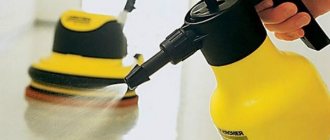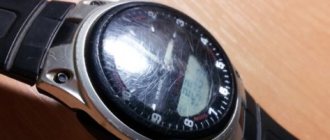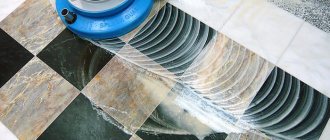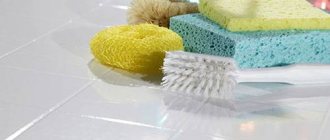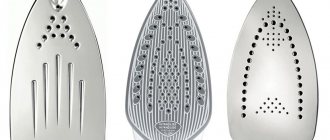- Finishing processing. Sometimes after polishing (or in parallel with it - it all depends on the initial state of the surface) crystallization is performed. In this case, the material is treated with slightly acidic compounds, which first partially dissolve the top layer of marble and then help strengthen it.
- eliminate coating defects;
- remove traces of use (wear, damage);
- give the surface shine;
- provide material protection that reduces future wear.
To briefly summarize, grinding with polishing and finishing of marble and granite allows you to achieve the following results:
The result should be something like this
What is grinding?
In order to understand how to grind and polish marble at home and in the workshop, you first need to explain: “What is grinding?”
Grinding is the name given to mechanical processing using an abrasive and/or diamond tool; grinding is used when it is necessary to remove differences after laying, when there are deep scratches left behind by a “saw” or “rope,” or those that appear as a result of use.
Go to category:
Polishing products Grinding and polishing tools Grinding and polishing machines
Today on the market you can find a large number of different grinding tools, therefore, in order to figure out which tool to use to remove “damage”, below is a table that indicates which tool to choose based on the depth of such “damage”.
| Drop | Diamond/abrasive fraction |
| Up to 1.5 mm | #80/100 |
| From 1.5 to 5 mm | #40/60 |
| Over 5 mm | #30/40 |
Why do you need to polish marble?
Often, when laying tiles or marble slabs on the floor, large and small differences remain, this occurs not only due to the qualifications of the craftsman performing the work, but also due to errors during production, and in order to achieve a monolithic effect, achieve high-quality polishing ( rich color and glossy shine), first you need to sand the surface well and remove all differences.
The most common damage after which it is necessary to resort to grinding
- Error during slab production;
- Poor installation;
- Deep scratches;
- Chips, cracks and potholes
Preparatory work
We have reviewed the necessary tools and equipment. Now let's start the process:
- Carefully inspect the surface for defects.
- Fill the cracks with cement-lime and resin fill. An alternative is liquid glass.
- If the marble breaks off somewhere, the pieces should be returned to their place using glue based on synthetic resins.
- Cracks are sealed with special mastics based on perchlorinated varnish or synthetic glue. Additionally, for protection, it is worth using fastenings made of copper staples or stainless steel elements.
Grinding and polishing methods
Methods can be divided into 2 groups: dry
and
wet
.
And each group can already be divided into manual
and
machine
methods
When it comes to machine grinding and polishing, in most cases they use water
, and when it comes to manual processing, craftsmen are divided 50/50
A tool that is suitable for a machine tool is not always suitable for a manual machine, because... a manual machine cannot provide the required pressure, and even if it can somehow be achieved, the engine power of the manual machine will not be enough to rotate the shaft. In turn, a tool for a hand-held machine can be adapted for a machine, but such a tool will wear out quickly (since a bunch of hand-held wheels is usually softer), so in this case we recommend working with minimal pressure.
All things being equal, we recommend using the wet method, because... the color and quality of polishing is better (no shagreen, polishing does not “burn”), although it is not always possible to work with water, for example, you cannot work with water when you have to work at low temperatures.
But sometimes masters prefer a combined method. Sand dry and add a little water to finish. In this case, the master sees whether he has missed any part of the surface, without waiting for the slab to dry, and by adding water at the last numbers (starting from number 800), it is possible to reduce the effect of “burnt” polishing. But we also draw your attention to the fact that not every tool designed for working with the “dry” method is suitable for working with water.
Recommendations for caring for marble
Marble can be cleaned with a thick solution of gum arabic. Using a brush, they cover the surface of artificial marble. When the product is completely dry, it is removed from the surface. Along with the dried solution, foreign substances that contaminate the marble are also removed.
You can lay a carpet on the marble floor at the entrance doors. It will protect against the pressure of shoes on it.
Artificial marble does not tolerate stains. When they appear, you should immediately use a towel, wiping and drying the surface. Grease stains can be removed with a piece of wet clay.
Traces of oil, cosmetics, and other organic substances are removed with absorbent paste. Rust is removed with an oxide neutralizer.
To remove traces of corrosion, scale and some other damage to the floor, minor repairs and repolishing of the surface will be required.
What power tools will you need?
For manual work, we recommend using grinders with water supply. And also with speed control, but not every machine with speed control is suitable for processing natural stone.
Required speed range for the machine: 400-4500
rpm (required recommended speed for working with grinding and polishing wheels with a diameter of
100
mm).
Also, if you do not have the opportunity to purchase a machine with speed control, it is possible to use a machine with constant speed in the range 3000-3700
(for working with circles with a diameter of
100
mm).
In the case of machines with speeds over 4500
rpm, some craftsmen manage to achieve good polishing, but during work they have to constantly “open” the tool
When the diamond located on the surface of the polishing and/or grinding wheel has exhausted its service life, it is necessary to remove the layer of the binder (“ligament”) and open new diamonds, at the correct speed and pressure - this happens by itself, at increased speeds, you have to resort to processing abrasive material (for example, it is possible to open the tool on concrete)
For mechanical work on objects (for grinding and polishing floors), we recommend using rotary machines. When choosing a machine, it is important to understand what productivity you will need, how many squares per day you want to produce. Also, the choice of machine depends on what materials you are mainly going to polish.
Many polishers do not intend to deal with granite; for them, it is enough to purchase a machine with the power 2,2
kW (granite can also be polished with such a machine, but the productivity will be quite low).
To polish granites and quartzites, you need machines with a power of 3 kW (for example: Floor grinding machine 430-IN 3.7 kW/220V CHA
), such a machine can easily cope with both marble grinding and granite grinding (when it is necessary to increase the pressure when using weights).
The key to good polishing is high-quality grinding
To work using the machine method in a workshop, we recommend using several types of machines; you can choose one or another type of machine based on the expected (calculated) productivity. Below is a table with machines that have stood the test of time and whose reliability we have no doubt about.
| Machine type and model | |
| Knee-lever machines | Model: Grinding and polishing machine ZLMS 2600 (5.5 kW/380V) VSN |
| Bridge Polishing Machine | Model: AS01.1, manufactured by Promasz (Poland) |
Possible problems with marble surfaces
Marble is a type of rock of limestone origin that has been exposed to high temperatures and pressure. Since ancient times, this mineral has been popular among artisans and builders, but even today it has not lost its value and relevance. Its visual appeal, variety of color variations and unusual texture make it such a sought-after material for the manufacture of products and floor coverings.
However, countertops made of marble have a number of disadvantages and are demanding to maintain. Small pits with a slightly rough surface to the touch are the result of etching the stone. This can happen after contact with fruit and vegetable acids, or after spilling red wine or vinegar, and sometimes even after cleaning the work surface with acidic or large-particle cleaning powders.
In kitchen interiors you can often find a matte marble countertop; this choice allows you to minimize the formation of defects; the glossy surface, which is most popular, often highlights all the shortcomings.
In any case, the attractiveness of marble and its value can neutralize possible everyday difficulties, and the possibility of restoring the stone surface adds another plus to this material.
Grinding and polishing in stages
In order to achieve high-quality polishing at the end, it is necessary to go through all stages of polishing. And the more such stages (“transitions”) you have, all things being equal, the better polishing you can get. Also, when polishing, there should be no rush, because if you have not worked well enough with some number, it can only come out at the finish and you will have to return to the previous stages, which will not only increase the processing time in general, but also increase the wear of the tool.
At the first stage
we need to remove all deep scratches and large differences - this stage is called roughening (Diamond grain size
#30-100
).
Second phase
called polishing.
Depending on the material being processed, the grain size for this stage is: #200-400
. At this stage, the surface becomes smooth and uniform, but not yet shiny.
Third stage
- this is finishing (from number
600
to
1000
), - at this stage the color appears, and the surface begins to shine.
Fourth stage
called polishing and crystallization (from number
1500
to number
6000
(sometimes up to
10,000
), at this stage a “mirror” shine appears, but only if we have not neglected all the previous stages.
Some of our clients have problems with polishing, because... they do not prepare the surface well enough (they do not grind well enough). And this happens primarily because they use too fine a grain of diamond, which works when it is necessary to remove only small scratches.
To make sanding easy, you don’t need to be afraid to take rough numbers. If you follow the technology and do not stand still while polishing, but move evenly, the likelihood of “digging holes” will be minimal.
Preparatory activities before polishing
As mentioned earlier, good polishing without high-quality grinding is impossible. Therefore, to prepare the surface for polishing, you need to treat the entire surface: 30
,
60
and
100
number. Each subsequent number in this case removes risks from the previous one. If you miss any number, then there is a high probability that the difference will not be removed or the process of preparing the surface for the next stage will be greatly delayed.
DIY marble polishing
We are often asked whether it is possible to polish marble with your own hands at home. Of course you can polish it. But a beginner needs to follow a few simple rules:
- No need to hurry;
- No need to skip numbers;
- You must strictly follow the instructions for use.
What polishing products should I use?
To polish marble, we recommend using aluminum oxide or silicon oxide powders, as well as chemical crystallizers.
Crystallization of marble surface using powder
The powder must be evenly distributed over a surface area of no more than 3-4 square meters. meters, moisten with water and pass with a felt or felt circle. The surface must first be treated to number 800-1500. Afterwards, it is necessary to thoroughly rinse the surface with water - only then will we see a “mirror” shine (if all the previous stages are carried out well, we should not expect miracles from the crystallizer; if the surface is poorly prepared, then we may not see a good shine).
Crystallization of a marble surface using a liquid crystallizer (which contains weak acids)
The crystallizer must be sprayed evenly on a surface with an area of no more than 2 square meters. meters, then spread it over the surface using metallized felt, then polish it using white felt. The surface must first be treated to number 400-800. To achieve a glossy finish, it is necessary to remove any residue from the surface.
Polishing other natural stones
If polishing common marbles and granites is more or less simple and clear, it is enough to use the full line and slowly move from stage to stage - follow the technology. For some materials, simply following the instructions on the website is not enough
For example, polishing artificial materials (agglomerates) is impossible without water. For black marbles, it is necessary to use an aging brush during the polishing process (to obtain a rich color), and on some materials it is impossible to obtain a good polish without the use of resin.
Therefore, before ordering this or that line, if you have not processed the material before, talk to a consultant and send a photo. And then we will be able to select for you a ruler that will really work and you will not have to overpay for an unnecessary tool that does not work not because it is bad or of poor quality, it is simply not suitable for your task.
Crystallization of marble
This marble processing technology involves chemical impregnation of the surface with crystallizers - weakly acidic substances that heal scratches and strengthen the surface of the stone. Before carrying out this procedure, the marble surface should be thoroughly polished.
The result is an increase in the quality of polishing, the marble becomes more durable, and its appearance improves.
The treatment is carried out before final polishing of the marble using a special rotary machine. A weakly acidic product is applied to the surface and thoroughly rubbed over the entire coating.
During crystallization, the top layer of the material softens under the influence of weakly acidic agents. Then it freezes again. Thus, small cracks and scratches are removed, and the surface itself becomes mirror-like.
Is it still worth doing the polishing yourself?
If you are ready to honestly follow the technology and you have enough time and patience, then you will definitely succeed. Whether it is advisable to do this or not is probably not for us to decide. We believe that if you need to polish a product once at home or at the dacha, you should probably trust and pay a professional, but if you are going to do it periodically, then the time spent studying the technology will be justified.
Go to category:
Polishing products Grinding and polishing tools Grinding and polishing machines
Tools
Although marble grinding and polishing equipment is now available in retail stores, you may be tempted to make do with simpler tools. The most common of them is the angle grinder. It also belongs to the repolishing equipment, but is more accessible and widespread than other mechanisms with similar functions.
With the help of a grinder you can process both large surfaces and hard-to-reach areas. But it is not very suitable for working with marble. For this stone, mechanisms that make a small number of revolutions per minute are better suited. Using this technique will eliminate the possibility of “licking” the surface, forming a kind of “orange peel”; the polished stone will have the correct shine and texture.
As an option, you can use flexible diamond discs. Choosing the right equipment is an important part of the question “how to polish marble.”
Protective coatings
The last stage in the restoration of marble and granite floors is the application of special protective coatings to the stone. Among other things, they can significantly reduce the cost of routine maintenance of stone floors.
Hydrophobization and impregnation of marble floors
For such impregnation, various chemical compositions are used, which form a protective film on the surface of the material. It is completely transparent and has a water-repellent effect, while being vapor permeable. Compositions based on organosilicon compounds can also be used.
If necessary, it can be easily removed using a special device. This device operates at water temperatures up to 140 degrees and creates a pressure of 30 bar. After the procedure is completed, the floors are dried and a new coating is applied.
Marble floor and staircase in the interior Source dekormyhome.ru
In addition to chemicals, waxing is often used to make marble hydrophobic. To do this, the surfaces to be treated are rubbed with wax or impregnated with wax-based solutions. Next comes polishing. Giving hydrophobic properties is a mandatory procedure for high-quality cleaning or restoration of marble coatings.
Application of a polymer protective coating
Without applying a protective polymer coating, marble and even granite floors quickly begin to lose their presentable appearance. Even fine sand that remains on shoes after walking outside can cause significant damage to the floor covering. It gradually fades due to constant scratches.
The polymer coating allows you to reliably protect the stone floor for several months. In addition, the polymer film also has a cosmetic effect. With its help, cracks and scratches are hidden, even if the floor is laid in a public place, the surface is properly leveled.
Applying varnishes with a wet stone effect
Applying varnishes with a “wet stone” effect is a fairly popular and in-demand service. The film created is transparent and perfectly emphasizes the texture of the material, making it more saturated. The slight “silkyness” obtained after processing also looks very impressive.
Protective coating with a “wet stone” effect Source dekoriko.ru
Removing plant stains from pools, fountains and showers
Not even stains, but just mold, moss, algae, lichen or fungi often appear where it is damp and humid. Accordingly, their formation can easily be assumed in fountains, pools and showers made of marble. All these formations can be easily removed from the marble surface with simple hydrogen peroxide or ammonia.
ATTENTION! Never allow hydrogen peroxide and ammonia to be mixed - their combination creates a chemical reaction, the result of which is a poisonous, deadly gas!
